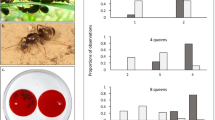Abstract
Cooperation among workers and their seeming altruism result from strict policing by nestmates.
Similar content being viewed by others
Main
Workers of many species of ant, bee and wasp do not lay eggs, despite having functional ovaries1, but the selective causes of this extreme form of altruism are unclear2,3,4,5,6,7. Here we show that workers forego reproduction in response to the threat of their eggs being killed, or 'policed', by nestmates. Our results indicate that social coercion helps to explain worker altruism and cooperation in modern-day insect societies3,4,5.
Why, in some species, do most workers forego direct reproduction? One possibility is that worker altruism is voluntary: in this scenario, high genetic relatedness should drive the evolution of altruism2,3,4,5,6,7 and worker sterility7 because higher relatedness increases the indirect benefit of working. Theoretically, however, worker altruism could also be 'enforced' and may have evolved in response to social sanctions4,5,6. In many species, worker-laid eggs are killed by the queen or by other workers1,8,9 and, if these sanctions are effective, the advantage to workers of laying eggs is reduced. As a result, more would be selected to work altruistically, rather than to lay eggs6.
The role of sanctions in promoting worker sterility has long been suspected8,9, but has never been tested in a comparative study. We therefore studied ten single-queen species, nine Vespidae wasps (for example, see Fig. 1) and the honeybee Apis mellifera. These are the only species for which there are data to quantify both the proportion of non-egg-laying workers, a measure of worker altruism, and two key predictor variables: relatedness among workers, which depends on the frequency of queen mating, and the effectiveness with which worker-laid eggs are policed by nestmates1,8,9. We analysed the data by using individual species as data points and by phylogenetically independent contrasts (PICs) to control for phylogenetic non-independence. (See supplementary information.)
Figure 2 shows that, as predicted, fewer workers reproduce when the effectiveness of policing worker-laid eggs is higher (P = 0.00004, Fig. 2a; using PICs: P = 0.000006, see supplementary information). This supports the hypothesis that worker altruism is enforced. Contrary to the voluntary-altruism hypothesis7, however, higher relatedness does not lead to increased altruism. In fact, the reverse is true — a larger proportion of the workers reproduce in species where relatedness is high (P = 0.004, Fig. 2b; using PICs: P = 0.04; see supplementary information). However, this is predicted by policing theory, because low relatedness more strongly selects for workers to police each others' reproduction1,8.
a, If altruism is enforced, more workers should remain sterile when their reproduction is more effectively policed by nestmates, which is what occurs (R =−0.94, P = 0.00004; effectiveness of policing is reverse log10-transformed). b, If altruism is voluntary, greater altruism and less worker reproduction should be seen when relatedness is high, but the opposite occurs (R = 0.82, P = 0.004; percentage of reproductive workers is log10-transformed). The effectiveness of policing is defined as the probability of worker-laid eggs being killed relative to queen-laid eggs; reproductive workers are shown as the percentage of workers with active ovaries (see supplementary information).
Our results also show that policing effectiveness is negatively correlated with relatedness (R = −0.60, one-tailed P = 0.03; using PICs: F(1,8) = 4.69, one-tailed P = 0.03); this contrasts with our results from queenless colonies, in which the relationship is reversed and higher relatedness results in a smaller proportion of the workers laying eggs (R = −0.79, P = 0.007; using PICs: P = 0.03; see supplementary information). This is as expected from theory, as in queenless colonies policing does not occur and its inhibititory effect is lost7. However, the effect of relatedness in promoting altruism remains7.
The key role of relatedness in the evolution of self-sacrificing behaviour is widely recognized2,5. The origin of insect societies is one of the most cited examples, and high relatedness was probably required for worker behaviour first to evolve2,5. Nevertheless, our results show that in modern-day insect societies it is mainly social sanctions that reduce the numbers of workers that act selfishly. In this, they provide evidence for something that has proved notoriously hard to demonstrate in human society: that better law enforcement can lead to fewer individuals behaving antisocially10.
References
Wenseleers, T. & Ratnieks, F. L. W. Am. Nat. 168 http://www.journals.uchicago.edu/cgi-bin/resolve?id=doi:10.1086/508619.
Hamilton, W. D. J. Theor. Biol. 7, 1–52 (1964).
Alexander, R. D. Annu. Rev. Ecol. Systemat. 5, 325–383 (1974).
Frank, S. A. Evolution 57, 693–705 (2003).
Lehmann, L. & Keller, L. J. Evol. Biol. 19, 1365–1376 (2006).
Wenseleers, T., Hart, A. G. & Ratnieks, F. L. W. Am. Nat. 164, E154–E167 (2004).
Wenseleers, T., Helanterä, H., Hart, A. G. & Ratnieks, F. L. W. J. Evol. Biol. 17, 1035–1047 (2004).
Ratnieks, F. L. W. Am. Nat. 132, 217–236 (1988).
Ratnieks, F. L. W. & Visscher, P. K. Nature 342, 796–797 (1989).
Levitt, S. D. Am. Econ. Rev. 87, 270–290 (1997).
Author information
Authors and Affiliations
Corresponding author
Ethics declarations
Competing interests
The authors declare no competing financial interests.
Supplementary information
Supplementary Methods
(PDF 79 kb)
Rights and permissions
About this article
Cite this article
Wenseleers, T., Ratnieks, F. Enforced altruism in insect societies. Nature 444, 50 (2006). https://doi.org/10.1038/444050a
Received:
Accepted:
Published:
Issue Date:
DOI: https://doi.org/10.1038/444050a
This article is cited by
-
Social norms and superorganisms
Biology & Philosophy (2023)
-
Behavioral differentiation among workers may reduce reproductive conflicts during colony inheritance in the termite Reticulitermes labralis
Insectes Sociaux (2022)
-
Ten recent insights for our understanding of cooperation
Nature Ecology & Evolution (2021)
Comments
By submitting a comment you agree to abide by our Terms and Community Guidelines. If you find something abusive or that does not comply with our terms or guidelines please flag it as inappropriate.





